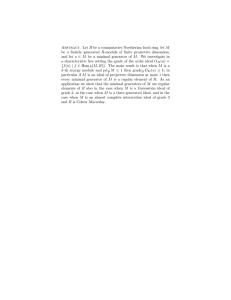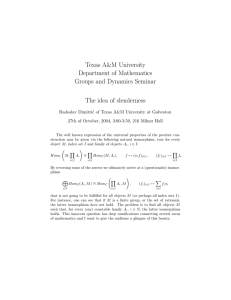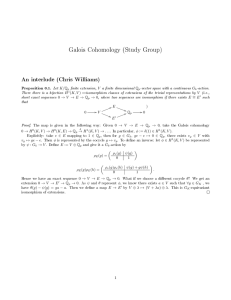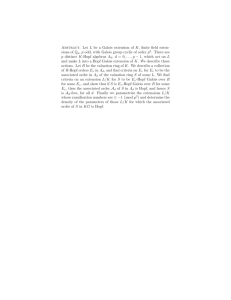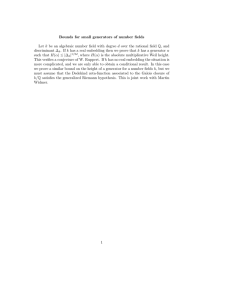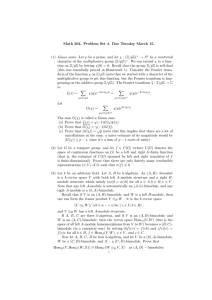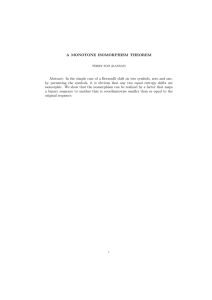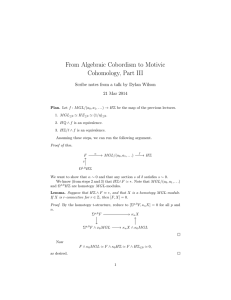Generators in module and comodule categories
advertisement
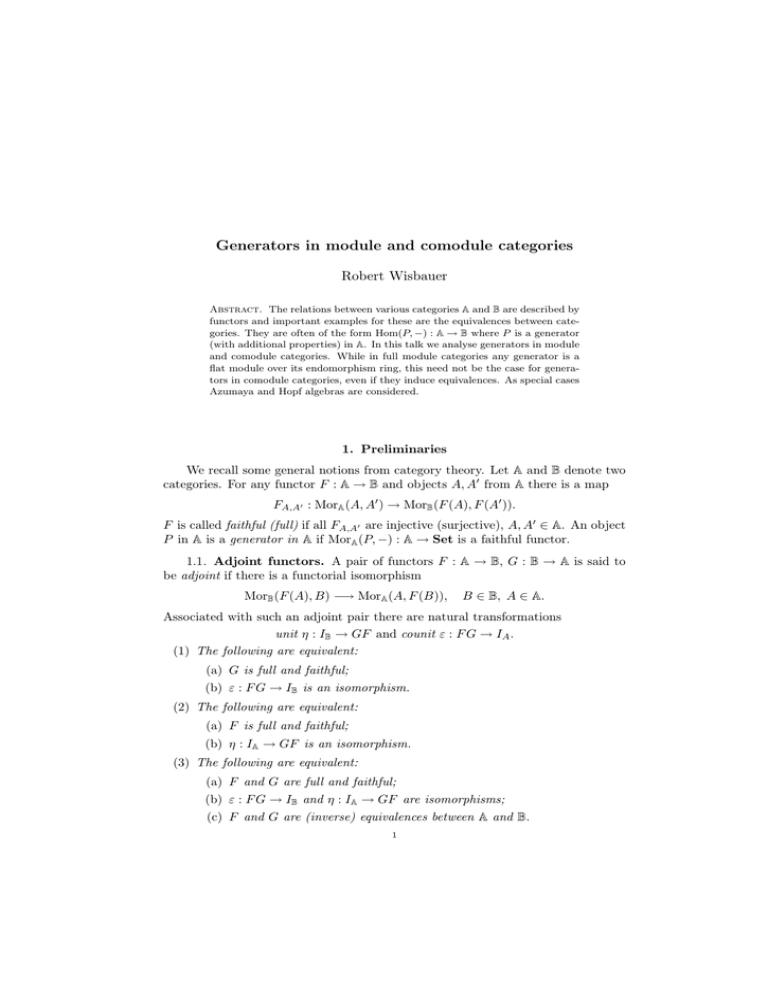
Generators in module and comodule categories
Robert Wisbauer
Abstract. The relations between various categories A and B are described by
functors and important examples for these are the equivalences between categories. They are often of the form Hom(P, −) : A → B where P is a generator
(with additional properties) in A. In this talk we analyse generators in module
and comodule categories. While in full module categories any generator is a
flat module over its endomorphism ring, this need not be the case for generators in comodule categories, even if they induce equivalences. As special cases
Azumaya and Hopf algebras are considered.
1. Preliminaries
We recall some general notions from category theory. Let A and B denote two
categories. For any functor F : A → B and objects A, A0 from A there is a map
FA,A0 : MorA (A, A0 ) → MorB (F (A), F (A0 )).
F is called faithful (full) if all FA,A0 are injective (surjective), A, A0 ∈ A. An object
P in A is a generator in A if MorA (P, −) : A → Set is a faithful functor.
1.1. Adjoint functors. A pair of functors F : A → B, G : B → A is said to
be adjoint if there is a functorial isomorphism
MorB (F (A), B) −→ MorA (A, F (B)),
B ∈ B, A ∈ A.
Associated with such an adjoint pair there are natural transformations
unit η : IB → GF and counit ε : F G → IA .
(1) The following are equivalent:
(a) G is full and faithful;
(b) ε : F G → IB is an isomorphism.
(2) The following are equivalent:
(a) F is full and faithful;
(b) η : IA → GF is an isomorphism.
(3) The following are equivalent:
(a) F and G are full and faithful;
(b) ε : F G → IB and η : IA → GF are isomorphisms;
(c) F and G are (inverse) equivalences between A and B.
1
2
ROBERT WISBAUER
In Grothendieck categories we have the following properties of generators (see
[Nas, III, Teoremǎ 9.1]).
1.2. Gabriel Popescu Theorem. Let A be a Grothendieck category, P a
generator in A, and S = EndA (P ). Then HomA (P, −) : A → S M has a left adjoint
T : S M → A and:
(1) ε : T HomA (P, −) → IA is a functorial isomorphism;
(2) HomA (P, −) is fully faithful;
(3) T is left exact.
2. Generators in the category of A-modules
In this section A will denote an associative ring with unit and A M denotes the
category of left A-modules. Morphisms of left modules should act from the right
while those of right modules are acting from the left.
Throughout P will be a left A-module and S = EndA (P ). Thus P is a right
S-module and there is a canonical ring morphism
φ : A → B = EndS (M ),
a 7→ [m 7→ am].
P is called balanced provided φ is an isomorphism.
2.1. Generators in A M - 1. For a module P in A M and S = EndA (P ), the
following are equivalent:
(a) P is a generator in A M;
(b) every A-module N is P -generated, that is, there is an epimorphism P (Λ) → N ,
Λ some index set;
(c)
(i) φ : A → B is an isomorphism and
(ii) PS is finitely generated and projective.
The characterisation given in (c) is due to Morita [Mor] (e.g. [Fai, Proposition
3.26], [WiFo, 18.8]). The interesting aspect of it is that it describes the universal
property of P being a generator in A M by internal properties of P as an R- and
an S-module. In particular, a generating property on the left side is related to a
projectivity property on the right.
2.2. Adjoint pair P ⊗S −, HomA (P, −). The functors
P ⊗S − : S M → A M, HomA (P, −) : A M → S M,
form an adjoint pair with functorial isomorphism for X ∈ S M, Y ∈ A M,
HomA (P ⊗S X, Y ) → HomS (X, HomA (P, Y )),
unit ηX : X → HomA (P, P ⊗S X), x 7→ [p 7→ p ⊗ x];
counit εY : P ⊗S HomA (P, Y ) → Y , p ⊗ f 7→ (p)f .
A special property of the category of A-modules is the fact that for a generator
P , the functor HomA (P, −) : A M → S M is not only faithful (required by the
definition) but also full. To show this we recall the following (e.g. [WiFo, 15.9]).
2.3. Modules flat over the endomorphism ring. For an A-module P and
S = EndA (P ), the following are equivalent:
(a) P is a flat right S-module;
(b) for any f : P n → P , n ∈ N, Ke f is P -generated.
GENERATORS IN MODULE AND COMODULE CATEGORIES
3
From 1.2 we obtain
2.4. Generators in A M - 2. For an A-module P the following are equivalent:
(a) HomA (P, −) : A M → S M is faithful;
(b) HomA (P, −) : A M → S M is fully faithful;
(c) ε : P ⊗S HomA (P, N ) → N is an isomorphism for any N ∈ A M;
(d) ε : P ⊗S HomA (P, N ) → N is surjective for any N ∈ A M.
Proof. (a)⇒(b) follows from the Gabriel Popescu Theorem 1.2.
The other implications are obvious.
The properties of generators strongly depend on the categories they generate.
For example, consider Gen(P ), the full subcategory of A M whose objects are the
P -generated modules. It is the largest subcategory for which P is a generator.
2.5. Generator in Gen(P). For an A-module P the following are trivial.
(1) P is a generator in Gen(P );
(2) HomA (P, −) : Gen(P ) → S M is faithful;
(3) εN : P ⊗S HomA (P, N ) → N is surjective for any N ∈ Gen(P ).
Here P need not be flat over its endomorphism ring unless Gen(P ) has special properties, e.g., is a Grothendieck category. To study this consider the full
subcategory σ[P ] of A M whose objects are subgenerated by P , that is, they are
submodules of P -generated modules. Since σ[P ] is a Grothendieck category, the
proof for 2.4 applies to show:
2.6. Generator in σ[P ] - 1. For an A-module P the following are equivalent:
(a) HomA (P, −) : σ[P ] → S M is faithful;
(b) HomA (P, −) : σ[P ] → S M is fully faithful;
(c) εN : P ⊗S HomA (P, N ) → N is surjective, N ∈ σ[P ];
(d) εN : P ⊗S HomA (P, N ) → N is an isomorphism, N ∈ σ[P ];
(e) PS is flat and εV is an isomorphism for all injectives V ∈ σ[P ].
Proof. (e)⇒(d) Let N be any module in σ[P ] and consider an exact sequence
0 → N → I1 → I2 in σ[P ] where I1 , I2 are (P -)injective modules in σ[P ]. Since PS
is flat we obtain a commutative diagram with exact rows
0
/ P ⊗S HomA (P, N )
0
/N
εN
/ P ⊗S HomA (P, I1 )
εI1
/ I1
/ P ⊗S HomA (P, I2 )
εI2
/ I2
By assumption, εI1 and εI2 are isomorphisms and hence so is εN . Thus P is a
generator in σ[P ] by 2.6.
The remaining assertions are obvious.
The question arises if one can - similar to Morita’s result for A M (see 2.1) characterise generators in σ[P ] by internal properties of P as an R- or S-module.
This can be derived from condition (e) in 2.6 by applying ideas from Zimmermann
[Zim]. For this we recall from [Zim] and [WiSta]:
4
ROBERT WISBAUER
2.7. L-dcc and P -dcc. For A-modules L, V , P and S = EndA (P ), consider
the canonical map
νL,P,V : L ⊗S HomR (P, V ) → HomR (HomS (L, P ), V ), l ⊗ f 7→ [g 7→ (g(l))f ],
which is an isomorphism provided LS is finitely presented and V is P -injective (e.g.,
[WiFo, 25.5]). Following Zimmermann [Zim, 3.2], we say that PS has L-dcc if αL,P
is a monomorphism for any injective V ∈ σ[P ]. The terminology indicates that the
condition is related to descending chain conditions on certain matrix subgroups
of P . In connection with the density property for P this can be understood as a
Mittag-Leffler condition on PS (e.g. [WiSta, 5.4]).
Putting L = P we see that P -dcc on P corresponds to the injectivity of
νP,V : P ⊗S HomA (P, V ) → HomA (HomS (P, P ), V ).
With the canonical map φ : A → B := HomS (P, P ) we obtain the commutative
diagram
νP,V
/ HomA (B, V )
P ⊗S HomA (P, V )
RRR
RRR
RR
φ∗
εV RRRR
RRR )
V.
As an injective module in σ[P ], V is P -generated and so εV is always surjective. If
φ∗ is an isomorphism, e.g., if φ : A → B is dense, then P has P -dcc if and only if
εV is an isomorphism for all injectives V ∈ σ[P ].
Thus Morita’s description of generators in A M can be generalised to generators
in σ[P ] in the following way (see [WiSta, Corollary 5.8]):
2.8. Generators in σ[P ] - 2. For an A-module P the following are equivalent:
(a) P is a generator in σ[P ];
(b) PS is flat and has P -dcc and
(i) φ : A → B is dense, or
(ii) φ∗ : HomA (B, V ) ' HomA (A, V ) for all (injective) V ∈ σ[P ].
3. Bimodules and Azumaya algebras
Let A denote an algebra over a commutative associative ring R with unit, with
multiplication µ : A ⊗R A → A and unit map η : R → A.
3.1. (A, A)-bimodules. Denote the category of (A, A)-bimodules by A MA .
This can also be considered as category of left modules over the enveloping algebra
A ⊗R Ao , that is we may identify A MA = A⊗R Ao M.
The center of an (A, A)-bimodule M is defined as
Z(M ) = {m ∈ M | am = ma for all a ∈ A}
and it is easily veryfied that
A HomA (A, M )
' Z(M ),
A EndA (A)
The multiplication µ factors via µ0 : A ⊗Z(A) A → A
' Z(A).
GENERATORS IN MODULE AND COMODULE CATEGORIES
5
Clearly A itself is an (A, A)-bimodule but in general it is neither projective nor
a generator in the category A MA . To describe this situation we apply the results
from the previous section to the adjoint pair of functors
A ⊗Z(A) − : Z(A) M → A MA ,
A HomA (A, −)
: A MA → Z(A) M.
3.2. Azumaya algebras. For a ring A, the following are equivalent:
(a) A is a generator in A MA ;
(b) A is a projective generator in
(c)
A HomA (A, −)
A MA ;
: A MA → Z(A) M is (fully) faithful;
(d) A ⊗Z(A) − : Z(A) M → A MA is an equivalence;
(e) A ⊗Z(A) Ao ' EndZ(A) (A) and AZ(A) is finitely generated and projective;
(f) A is projective in
A MA ;
(g) µ : A ⊗Z(A) A → A splits in
A MA .
Proof. The equivalence of (a), (c) and (e) is clear from 2.1 and 2.4.
(e)⇒(b) As a finitely generated, projective and faithful module over the commutative ring Z(A), A is a generator in Z(A) M (e.g. [WiFo, 18.10]) and thus, by
2.4, A is (finitely generated and) projective over EndZ(A) (A).
(b)⇒(f) and (f)⇔(g) are obvious.
(g)⇒(a) See, e.g., [WiBim, 28.7].
The theory sketched above can be extended in two different directions. Replace
by σ[A AA ], the full subcategory of bimodules subgenerated by A. The generating property in this category does not imply finiteness over the endomorphism
ring. Furthermore, replacing the ring A ⊗R Ao by the multiplication algebra, we
need no longer require the algebra A to be associative.
A MA
3.3. Multiplication algebra. Let A be a not necessarily associative R-algebra
with unit. Then left and right multiplications with any a ∈ A induce R-linear maps
La : A → A, x 7→ ax;
Ra : A → A, x 7→ xa.
The multiplication algebra of A is the (associative) subalgebra
M (A) ⊂ EndR (A) generated by {La , Ra | a ∈ A}.
We consider A as a left module over M (A) (finitely generated by 1A ); EndM (A) (A)
is isomorphic to the center of A. By σ[M (A) A], or σ[A] for short, we denote the full
subcategory of M (A) M subgenerated by A.
From 2.1 and 2.4 we derive immediately:
3.4. A as generator in M (A) M. For a (non-associative) algebra A with unit
the following are equivalent:
(a) A is a generator in M (A) M;
(b) A is a projective generator in
M (A) M;
(c) HomM (A) (A, −) : M (A) M → Z(A) M is (fully) faithful;
(d) εN : A ⊗Z(A) HomM (A) (A, N ) → N is sur(bi-)jective for any N ∈ M (A) M;
(e) φ : M (A) ' EndZ(A) (A) and AZ(A) is finitely generated and projective.
6
ROBERT WISBAUER
The properties justify to call the algebras described in 3.4 (non-associative)
Azumaya algebras (see [WiBim, 24.8]). Notice that - unlike in A⊗Z(A) Ao M - projectivity of A in M (A) M need not imply the generating property.
Applying 2.6 and 2.8 we obtain:
3.5. A as generator in σ[A]. For a (non-associative) algebra A with unit, the
following are equivalent:
(a) HomM (A) (A, −) : σ[A] → Z(A) M is (fully) faithful;
(b) εN : A ⊗Z(A) HomM (A) (A, N ) → N is sur(bi-)jective for any N ∈ σ[A];
(c) φ : M (A) → EndZ(A) (A) is dense and AZ(A) is flat and has A-dcc.
Note that the generating property of A in σ[A] need not imply projectivity.
3.6. A as projective generator in σ[A]. For a (non-associative) algebra A
with unit, the following are equivalent:
(a) A is a projective generator in σ[A];
(b) HomM (A) (A, −) : σ[A] → Z(A) M is an equivalence;
(c) A ⊗Z(A) − : Z(A) M → σ[A] is an equivalence;
(d) εN : A ⊗Z(A) HomM (A) (A, N ) → N is surjective (bijective) for any N ∈ σ[A];
(e) φ : M (A) → EndZ(A) (A) is dense and AZ(A) is faithfully flat and has A-dcc.
The rings considered in 3.6 are named Azumaya rings (e.g. [WiBim, 26.4]).
For example, any (non-associative) simple ring with unit is of this type.
Associative Azumaya rings are closely related to the ideal algebras studied by
M.L. Ranga Rao, a former student of Carl Faith (see [Rao]).
The theory sketched above can also be formulated for rings A without unit. In
this case the role of the center of A is taken over by the centroid of A, C(A) =
EndM (A) (A) (see [WiBim]).
4. Corings and comodules
Consider any coring (C, ∆, ε) over an associative ring A with unit, that is,
an (A, A)-bimodule C with bimodule morphisms ∆ : C → C ⊗A C and ε : C → A
satisfying the coassociativity and counitality conditions. We recall some elementary
facts from [BrWi, Chapter 3].
4.1. Category of comodules. Right C-comodules ared defined as right Amodules M with an A-linear map (coaction) %M : M → M ⊗A C satisfying the
coassociativity and counitality conditions.
Comodule morphisms f : M → N between C-comodules are those A-linear
maps inducing commutative diagrams
M
f
%M
M ⊗A C
/N
%N
f ⊗I
/ N ⊗A C.
The category of all right C-comodules is denoted by MC . It is an additive
category with direct sums and cokernels, and it is abelian provided C is flat as a
left A-module. There is a bijective natural map
ϕ : HomC (M, X ⊗A C) → HomA (M, X), f 7→ (IX ⊗ ε) ◦ f,
GENERATORS IN MODULE AND COMODULE CATEGORIES
7
which shows that the functor − ⊗A C is right adjoint to the forgetful functor
MC → MA . It also shows that the ring EndC (C) of comodule endomorphisms
of C is isomorphic to the dual ring C ∗ = HomA (C, A), the latter endowed with the
convolution product for f, g ∈ C ∗ , f ∗r g(c) = g((f ⊗ I)∆(c)).
Similarly, the left dual ∗ C = A Hom(C, A) is a ring with convolution product
l
f ∗ g(c) = f ((I ⊗ g)∆(c)). The counit ε is the unit for both C ∗ and ∗ C.
Every right C-comodule (M, %M ) has a left ∗ C-module structure given by
*: ∗ C ⊗R M → M,
f ⊗ m 7→ (IM ⊗ f ) ◦ %M (m).
Endowed with this structure, any C-comodule morphism f : M → N between
comodules is ∗ C-linear, that is
HomC (M, N ) ⊆ ∗ C Hom(M, N ),
thus inducing a faithful functor MC → ∗ C M.
This functor is full if and only if C is locally projective as a left A-module
(α-condition, [BrWi, 19.2]) and in this case MC is equivalent to σ[∗ C C], the full
subcategory of ∗ C M subgenerated by C. The comodule category MC is equal to
∗ C M if and only if A C is finitely generated and projective.
In general, MC is not an abelian category and hence the characterisations
of generators considered in earlier sections need not apply. This kind of defect
comes from the observation that monomorphisms in MC need not be injective
maps. However, if A C is flat, then MC is abelian and results similar to those in
section 2 can be obtained. In particular, if A C is locally projective, MC is the same
as σ[∗ C C] and propositions like 2.6 or 2.8 do apply directly.
4.2. Generators in MC . Let C be an A-coring with
S = EndC (P ). The following are equivalent:
(a) P is a generator in MC ;
AC
flat, P ∈ MC and
(b) HomC (P, −) : MC → MS is (fully) faithful;
(c) ε : HomC (P, −) ⊗S P → IMC is an isomorphism;
(d)
is flat and εV : HomC (P, V ) ⊗S P → V is an isomorphism for all injective
comodules V ∈ MC .
SP
The following notion generalises generators (see [WiGa3, 4.1]).
4.3. Galois comodules. Let C be an A-coring, P ∈ MC and S = EndC (P ).
P is said to be a Galois comodule if εV : HomC (P, V ) ⊗S P → V is an isomorphism
for all (C, A)-injective comodules V ∈ MC (i.e., V is injective with respect to Asplitting C-monomorphisms).
In case PA is finitely generated and projective, P being a Galois comodule can
be characterised by the single isomorphism ([WiGa3, 5.3])
εC : HomC (P, C) ⊗S P → C.
This implies that any coring C which is finitely generated and projective as a right
A-module is a right Galois comodule.
Clearly, if the functor HomC (P, −) is fully faithful, then P is a Galois comodule.
On the other hand, if P is a Galois comodule and S P is flat, then HomC (P, −) is
fully faithful and A C is flat, i.e., P is a generator in MC (see [WiGa3, 4.8]).
8
ROBERT WISBAUER
For a sketch of the way from Galois field extensions to Galois comodules we
refer to [WiGa1].
4.4. A as C-comodule. Given an A-coring C one may ask when A itself is a
C-comodule. This is the case when C has a grouplike element, that is, some g ∈ C
with ∆(g) = g ⊗ g and ε(g) = 1A . Then A is a right (and left) C-comodule by the
coactions
%A : A → C, a 7→ ga, (A% : A → C, a 7→ ag, )
and we denote A with this comodule structure by Ag (e.g. [WiGa2], [BrWi,
Section 28]). For M ∈ MC , the g-coinvariants of M are defined as
MgcoC = {m ∈ M | %M (m) = m ⊗ g}.
(1) ψM : HomC (Ag , M ) → MgcoC , f 7→ f (1A ), is an isomorphism.
(2) EndC (Ag ) ' AcoC
= {a ∈ Ag | ga = ag} (= centraliser of g in A).
g
(3) For any X ∈ MA , (X ⊗A C)coC ' HomC (Ag , X ⊗A C) ' X, and
C coC ' HomC (Ag , C) ' HomA (Ag , A) ' A,
which is a left A- and right EndC (Ag )-morphism.
Now one may ask when Ag is a Galois comodule. This leads to
4.5. Galois corings. For an A-coring C with a grouplike element g and B =
AcoC
g , the following are equivalent:
(a) εC : HomC (Ag , C) ⊗B A → C, f ⊗ a 7→ f (a), is an isomorphism;
(b) the (A, A)-bimodule map χ : A ⊗B A → C, 1A ⊗ 1A 7→ g, is a (coring)
isomorphism;
(c) εN : HomC (Ag , N ) ⊗B A → N is an isomorphism, for every (C, A)-injective
N ∈ MC .
(C, g) is called a Galois coring if it satisfies the above conditions.
As seen before Galois comodules are close to generators. This is recalled in the
4.6. Galois Coring Structure Theorem. (e.g., [BrWi, 28.19]). Let C be
an A-coring with grouplike element g and B = AcoC
g .
(1) The following are equivalent:
(a) (C, g) is a Galois coring and B A is flat;
(b) A C is flat and Ag is a generator in MC .
(2) The following are equivalent:
(a) (C, g) is a Galois coring and B A is faithfully flat;
(b) A C is flat and Ag is a projective generator in MC ;
(c)
AC
is flat and HomC (Ag , −) : MC → MB is an equivalence.
4.7. Ring extensions. To any ring extension B → A, an A-coring can be
associated by putting C = A ⊗B A with grouplike element g = 1A ⊗ 1A in C, called
the Sweedler A-coring.
The category of right comodules over this coring is isomorphic to the category
of descent data for the given ring extension (e.g. [BrWi, 25.4]). In this context the
results on Galois corings can be interpreted in the classical descent theory.
GENERATORS IN MODULE AND COMODULE CATEGORIES
Recall that if C satisfies the α-condition, then EndC (C) =
we get (e.g. [BrWi, 19.21]):
4.8. C as generator in MC . Let C be an A-coring with
Then MC = σ[∗ C C] and the following are equivalent:
(a) C is a generator in MC ;
(b)
∗C
∗C
AC
9
End(C) ' C ∗ and
locally projective.
Hom(C, −) : MC → MC ∗ is (fully) faithful;
(c) C is flat as a C ∗ -module and εN : C ⊗C ∗ HomC (C, N ) → N is an isomorphism
for N ∈ MC .
5. Bimodules and Hopf algebras
In this section R denotes again a commutative associative ring with unit.
5.1. Bialgebras and bimodules. An R-module B is called a bialgebra if it
has an algebra structure (B, µ, η) and a coalgebra structure (B, ∆, ε),
µ : B ⊗R B → B, η : R → B, ∆ : B → B ⊗R B, ε : B → R,
such that ∆ and ε are algebra morphisms, or, equivalently, µ and η are coalgebra
morphisms where B ⊗R B is endowed with the canonical algebra and coalgebra
structure (induced by the twist map B ⊗R B → B ⊗R B).
A (mixed) B-bimodule is an R-module M with structural maps
ρM : M ⊗R B → M,
ρM : M → M ⊗R B.
satisfying the compatibility condition
ρM (mb) = ρM (m) · ∆(b), for b ∈ B, m ∈ M.
Category of B-bimodules. The category of right B-bimodules is denoted
by MB
B . Its objects are B-bimodules and the morphisms are R-linear maps which
are both B-module and B-comodule morphisms.
MB
B is an additive category with coproducts and cokernels. Similar to the category of comodules over a coalgebra (and for the same reasons), MB
B has coproducts
and cokernels but not necessarily kernels. It is abelian (and in fact Grothendieck)
provided B is flat as an R-module.
Naturally, B is a B-bimodule and EndB
B (B) = R. However, B need not be a
subgenerator in MB
while
B
⊗
B
always
is.
R
B
B ⊗R B can be considered as a B-coring and the category MB
B is equivalent to
the category MB⊗R B of right B ⊗R B-comodules. In particular, B is in MB⊗R B
and 1B ⊗ 1B is a group like element (see 4.5).
B induces the (free) functor
B
φB
B : MR → MB ,
M 7→ (M ⊗R B, IM ⊗ µ, IM ⊗ ∆),
which is full and faithful by the natural isomorphisms for X, Y ∈ MR ,
B
HomB
B (B ⊗R X, B ⊗R Y ) ' HomR (X, B ⊗R Y ) ' HomR (X, Y ).
We have the adjoint pair of functors
B
φB
B : MR → MB ,
B
HomB
B (B, −) : MB → MR ,
B
and since φB
B is full and faithful we know (from 1.1) that η : I → HomB (B, B ⊗R −)
is an isomorphism.
10
ROBERT WISBAUER
Handling bialgebras there is a notion which does not show up in the settings
considered so far.
5.2. Antipodes. Given a bialgebra B, besides composition, EndR (B) has
another associative product, the convolution product, given by
f ∗ g(b) = (f ⊗ g)∆(b) for f, g ∈ EndR (B) and b ∈ B.
An element S ∈ EndR (B) is called an antipode of B if it is inverse to IB with
respect to the convolution product ∗. So, by definition,
µ ◦ (S ⊗ IB ) ◦ ∆ = µ ◦ (IB ⊗ S) ◦ ∆ = η ◦ ε .
Notice that as an endomorphism of B, S need neither be injective nor surjective.
In the next theorem no assumptions are made on the R-module structure of B
(see [BrWi, 15.5 and 36.16]).
5.3. Hopf algebras - 1. For an R-bialgebra B the following are equivalent:
B
(a) HomB
B (B, −) : MB → MR is full and faithful;
B
(b) εN : HomB
B (B, N ) ⊗R B → N is an isomorphism for any N ∈ MB ;
B
(c) HomB
B (B, −) : MB → MR is an equivalence (with inverse − ⊗R B);
(d) B ⊗R B is a Galois B-coring;
(e) γB : B ⊗R B → B ⊗R B, a ⊗ b 7→ (a ⊗ 1B )∆(b), is an isomorphism;
(f) B has an antipode.
Bialgebras B with these properties are called Hopf algebras.
The equivalence of (c) and (f) is known as the Fundamental Theorem of Hopf
algebras. Notice that here HomB
B (B, −) is fully faithful but nevertheless B need
not be flat over its endomorphism ring R. This comes from the fact that monomorphisms in MB
B need not be injective maps.
If B is assumed to be flat as an R-module, B is a Hopf algebra if and only if
B is a generator in the (Grothendieck) category MB
B . Assuming B to be a locally
projective R-module we can get more characterisations for such bialgebras. For
this we consider the
5.4. Smash product. If BR is locally projective, then the comodules in MB
can be identified with the B ∗ -modules subgenerated by the comodule B.
Thus, if B is a bialgebra, the objects in MB
B can be considered as B-modules
with a B ∗ -module structure satisfying some compatibility conditions. Thus the
bimodules allow the structure of left modules over the smash product B#B ∗ , which
is defined as the R-module B ⊗R B ∗ with multiplication
(a ⊗ f )(b ⊗ g) := ((∆b)(a ⊗ f )) (1B ⊗ g).
Similar to the case of comodules we may identify
MB
B = σB#B ∗ [B ⊗R B] ⊂ B#B ∗ M,
where MB
B = B#B ∗ M if and only if BR is finitely generated (and projective).
In the situation described above we can refer to 2.6 and 2.8 to describe Hopf
algebras (see also [BrWi, 15.5]). The results are similar to the characterisations of
Azumaya rings (see 3.6).
GENERATORS IN MODULE AND COMODULE CATEGORIES
11
5.5. Hopf algebras - 2. For an R-bialgebra B with BR is locally projective,
the following are equivalent:
(a) B is a generator in MB
B;
B
(b) HomB
B (B, −) : MB → MR is (full and) faithful;
∗
(c) B is a subgenerator in MB
B and φ : B#B → EndR (B) is dense;
B
(d) εV : HomB
B (B, V ) ⊗R B → V is an isomorphism for injectives V ∈ MB .
Special cases of the preceding results can be found in [WiMod] where further
applications of these techniques to module algebras and group actions on algebras
are outlined.
In [WiAlg] and [MeWi] the theory of bialgebras and Hopf algebras is generalised to endofunctors of arbitrary categories.
References
[BrWi] Brzeziński, T. and Wisbauer, R., Corings and Comodules, London Math. Soc. LN Series
309, Cambridge University Press (2003)
[Fai] Faith, C., Algebra: Rings, modules and categories. I, Springer-Verlag, Berlin-HeidelbergNew York (1973)
[MeWi] Mesablishvili, B. and Wisbauer, R., Bimonads and Hopf monads on categories,
arXiv:0710.1163
[Mor] Morita,K., Duality for modules and its applications to the theory of rings with minimum
condition, Sci. Rep. Tokyo Kyoiku Daigaku, Sect. A 6, 83-142 (1958)
[Nas] Nǎstǎsescu, C., Rings. Modules. Categories. (Inele. Module. Categorii.). (Romanian) Bucuresti: Editura Academiei Republicii Socialiste Romania (1976)
[Rao] Rao, M.L. Ranga, Azumaya, semisimple and ideal algebras, Bull. Am. Math. Soc. 78, 588592 (1972)
[WiFo] Wisbauer, R., Foundations of module and ring theory, Algebra, Logic and Applications.
3, Gordon and Breach, Philadelphia (1991)
[WiBim] Wisbauer, R., Modules and algebras: bimodule structure and group actions on algebras,
Pitman Mon. Pure Appl. Math. 81, Addison Wesley Longman, Harlow, Essex (1996)
[WiSta] Wisbauer, R., Static modules and equivalences, Interactions between ring theory and
representations of algebras. Proc. conf. in Murcia, Van Oystaeyen, F. (ed.) et al., Marcel
Dekker, New York, LN Pure Appl. Math. 210, 423-449 (2000)
[WiMod] Wisbauer, R., Module and comodule categories – a survey, Proc. 2. Palest. Intern.
Conference, West Bank, Palestine, 1998, Elaydi, S. (ed.) et al., World Scientific, Singapore,
277-304 (2000)
[WiGa1] Wisbauer, R., From Galois field extensions to Galois comodules, Advances in ring theory,
Proc. 4th China-Japan-Korea conference, Nanjing, China, Chen, J.L. (ed.) et al., World
Scientific, New York, 263-281 (2005)
[WiGa2] Wisbauer, R., On Galois corings, Hopf algebras in noncommutative geometry and
physics. Proc. Conf. Brussels 2002, Caenepeel, S. (ed.) et al., Marcel Dekker, New York,
LN Pure Appl. Math. 239, 309-320 (2005)
[WiGa3] Wisbauer, R., Galois comodules, Commun. Algebra 34(7), 2683-2711 (2006)
[WiAlg] Wisbauer, R., Algebras versus coalgebras, Appl. Categ. Struct. 16(1-2), 255-295 (2008)
[Zim] Zimmermann, W., Modules with chain conditions for finite matrix subgroups, J. Algebra
190, 68-87 (1997)
Department of Mathematics, Heinrich Heine University, 40225 Düsseldorf, Germany
E-mail address: wisbauer@math.uni-duesseldorf.de
